Equus (genus)
| Equus Temporal range: 1.8–0 Ma Early Pleistocene to Recent | |
|---|---|
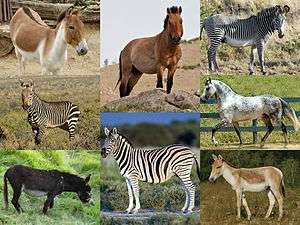 | |
| Clockwise (from top left): kiang (E. kiang), Przewalski's horse (E. ferus przewalskii), Grévy's zebra (E. grevyi), domestic horse (E. f. caballus), onager (E. hemionus), plains zebra (E. quagga), donkey (E. africanus asinus) and mountain zebra (E. zebra) | |
| Scientific classification | |
| Kingdom: | Animalia |
| Phylum: | Chordata |
| Class: | Mammalia |
| Order: | Perissodactyla |
| Family: | Equidae Gray, 1821 |
| Genus: | Equus Linnaeus, 1758 |
| Species | |
|
E. africanus—African Wild Ass | |
Equus is a genus of mammals in the family Equidae, which includes horses, asses, and zebras. Within Equidae, Equus is the only recognized extant genus, comprising seven living species. The term equine refers to any member of this genus, including horses. Like Equidae more broadly, Equus has numerous extinct species known only from fossils. The genus most likely originated in North America and spread quickly to the Old World. Equines are odd-toed ungulates with slender legs, long heads, relatively long necks, manes (erect in most subspecies) and long tails. All species are herbivorous, and mostly grazers with simpler digestive systems than ruminants but able to subsist on lower quality vegetation.
While the domestic horse and donkey (along with their feral descendants) exist worldwide, wild equine populations are limited to Africa and Asia. Wild equine social systems come in two forms; a harem system with tight-knit groups consisting of one adult male or stallion, several females or mares and their young or foals; and a territorial system where males establish territories with resources that attract females, which associate very fluidly. In both systems, females take care of their offspring but males may play a role as well. Equines communicate with each other both visually and vocally. Human activities have threatened wild equine populations and out of the seven living species, only the plains zebra remains widespread and abundant.
Etymology
The word equus is Latin for "horse",[1] and is cognate with the Greek "ἵππος" (hippos), "horse",[2] and Mycenaean Greek i-qo /ikkʷos/ (cf. the alternative development of the Proto-Greek labiovelar in Ionic "ἴκκος" ikkos[3][4]), the earliest attested variant of the Greek word, written in Linear B syllabic script.[5]
Taxonomy and evolution
| |||||||||||||||||||||||||||||||||||||||||||||||||||||||||||||||||||||||||||
| Cladogram of Equus after Vilstrup et al. (2013).[6] |
The genus Equus was first described by Carl Linnaeus in 1758. It is the only recognized extant genus in the family Equidae.[7] The first equids were small, dog-sized mammals (e.g. Eohippus) adapted for browsing on shrubs during the Eocene, around 54 million years ago (mya). These animals had three toes on the hind feet and four on the front feet with small hooves in place of claws but also had soft pads.[8] Equids developed into larger, three-toed animals (e.g. Mesohippus) during the Oligocene and Miocene.[7][8] From there, the tridactyl toes became progressively smaller through the Pleistocene until the emergence of the single-toed Equus.[9]
The genus Equus, which includes all extant equines, is believed to have evolved from Dinohippus, via the intermediate form Plesippus. One of the oldest species is Equus simplicidens, described as zebra-like with a donkey-like head shape. The oldest material to date was found in Idaho, USA. The genus appears to have spread quickly into the Old World, with the similarly aged E. livenzovensis documented from western Europe and Russia.[9] Molecular phylogenies indicate that the most recent common ancestor of all modern equines (members of the genus Equus) lived ~5.6 (3.9-7.8) mya. Direct paleogenomic sequencing of a 700,000-year-old middle Pleistocene horse metapodial bone from Canada implies a more recent 4.07 mya for the most recent common ancestor within the range of 4.0 to 4.5 mya.[10]
Mitochondrial evidence supports the division of Equus species into non-caballoid (which includes zebras and asses) and caballoids or "true horses" (which includes E. ferus and E. przewalskii).[6][11] Of the extant equine species, the lineage of the asses may have diverged first,[7] possibly as soon as Equus reached the Old World.[11] Zebras appear to be monophyletic and differentiated in Africa where they are endemic.[6]
Molecular dating indicates the caballoid lineage diverged from the non-caballoids 4 mya.[6] Genetic results suggest that all North American fossils of caballine equines, as well as South American fossils traditionally placed in the subgenus E. (Amerhippus), belong to E. ferus.[12] Remains attributed to a variety of species and lumped together as New World stilt-legged horses (including E. francisci, E. tau, and E. quinni) probably all belong to a second species that was endemic to North America.[13] The possible causes of the extinction of horses in the Americas (ca. 12,000 years ago) have been a matter of debate. Hypotheses include climate change and overexploitation by newly arrived humans.[14][15] Horses only returned to the American mainland with the arrival of the conquistadors in 1519.[16]
All species and subspecies
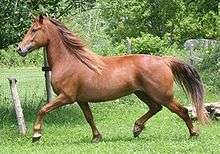

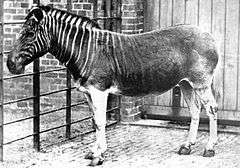


[extinct species/subspecies are marked with †]
- Genus Equus
- Subgenus Equus
- Equus ferus Wild horse
- Equus ferus caballus Domestic horse
- †Equus ferus ferus Tarpan
- Equus ferus przewalskii Przewalski's horse
- †Equus algericus
- † North American caballid horses (Pleistocene; most likely synonymous with E. ferus):
- †Equus lambei Yukon wild horse
- †Equus niobrarensis
- Subgenus †Amerhippus (this subgenus and its species are possibly synonymous with E. ferus)[12]
- †Equus alaskae
- †Equus andium
- †Equus neogeus
- †Equus santaeelenae
- †Equus scotti
- †Equus niobrarensis
- †Equus conversidens Mexican horse
- †New World stilt-legged horse (all following species within the group may be synonyms or ecomorphs of a single species)[13]
- Equus ferus Wild horse
- Subgenus Asinus
- Equus africanus African wild ass
- Equus africanus africanus Nubian wild ass
- Equus africanus asinus Domestic donkey
- †Equus africanus atlanticus Atlas wild ass
- Equus africanus somalicus Somali wild ass
- Equus hemionus Onager or Asiatic ass
- Equus hemionus hemionus Mongolian wild ass
- †Equus hemionus hemippus Syrian wild ass
- Equus hemionus khur Indian wild ass
- Equus hemionus kulan Turkmenian kulan
- Equus hemionus onager Persian onager
- Equus kiang Kiang
- Equus kiang chu Northern kiang
- Equus kiang kiang Western kiang
- Equus kiang holdereri Eastern kiang
- Equus kiang polyodon Southern kiang
- †Equus hydruntinus European ass
- †Equus altidens
- †Equus tabeti
- †Equus melkiensis
- †Equus graziosii
- Equus africanus African wild ass
- Subgenus Dolichohippus
- Equus grevyi Grévy's zebra
- †Equus koobiforensis
- †Equus oldowayensis
- Subgenus Hippotigris[lower-alpha 1]
- Equus quagga Plains zebra
- Equus quagga boehmi Grant's zebra
- Equus quagga borensis Maneless zebra
- Equus quagga chapmani Chapman's zebra
- Equus quagga crawshayi Crawshay's zebra
- Equus quagga burchellii Burchell's zebra
- †Equus quagga quagga Quagga
- Equus quagga selousi Selous' zebra
- Equus zebra Mountain zebra
- Equus zebra hartmannae Hartmann's mountain zebra
- Equus zebra zebra Cape mountain zebra
- †Equus mauritanicus
- Equus quagga Plains zebra
- Subgenus †Parastylidequus
- †Equus parastylidens Mooser's horse
- incertae sedis
- †Equus simplicidens Hagerman horse
- †Equus cumminsii
- †Equus livenzovensis
- †Equus sanmeniensis
- †Equus teilhardi
- †Equus numidicus
- †Equus plicidens
- †Equus stenonis group
- †Equus stenonis
- †Equus stenonis guthi
- †Equus stenonis senezensis
- †Equus stenonis pamirensis (Hippotigris pamirensis)
- †Equus stenonis petraloniensis
- †Equus stenonis vireti
- †Equus sivalensis
- †Equus stehlini
- †Equus bressanus
- †Equus sussenbornensis
- †Equus verae
- †Equus namadicus
- †Equus stenonis
- †subgenus Allozebra & Hesperohippus
- †Equus idahoensis
- †Equus (A.) occidentalis
- †Equus A. excelsus
- †Equus (H.) pacificus
- †Equus complicatus
- †Equus fraternus[17]
- Equus major
- †Equus giganteus group
- †Equus giganteus
- †Equus pectinatus
- †Equus crinidens
- Subgenus Equus
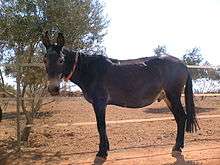
Hybrids
Equines species can crossbreed with each other. The most common hybrid is the mule, a cross between a male donkey and a female horse. With rare exceptions, these hybrids are sterile and cannot reproduce.[18] A related hybrid, a hinny, is a cross between a male horse and a female donkey.[19] Other hybrids include the zorse, a cross between a zebra and a horse[20] and a zonkey or zedonk, a hybrid of a zebra and a donkey.[21] In areas where Grévy's zebras are sympatric with plains zebras, fertile hybrids do occur.[22]
Biology
Physical characteristics
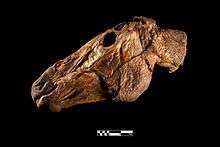
Equines have significant differences in size, though all are characterized by long heads and necks. Their slender legs support their weight on one digit (which evolved from the middle digits). The Grévy's zebra is the largest wild species, standing up to 13.2 hands (54 inches, 137 cm) and weighing up to 405 kg (890 lb).[23] Domesticated horses have a wider range of sizes. Heavy or draft horses are usually at least 16 hands (64 inches, 163 cm) high and can be as tall as 18 hands (72 inches, 183 cm) and weigh from about 700 to 1,000 kilograms (1,500 to 2,200 lb).[24] Some miniature horses are no taller than 30 inches (76 cm) in adulthood.[25] Sexual dimorphism is limited in equines. The penis of the male is vascular and lacks a bone (baculum). Equines are adapted for running and for traveling over long distances. Their dentition is adapted for grazing; they have large incisors that clip grass blades and highly crowned, ridged molars well suited for grinding. Males have spade-shaped canines ("tushes"), which can be used as weapons in fighting. Equines have fairly good senses, particularly their eyesight. Their moderately long, erect ears are movable and can locate the source of a sound.[7][26]
A dun-colored coat with primitive markings that include a dorsal stripe and often leg striping and transverse shoulder stripes reflect the wildtype coat and are observed in most wild extant equine species.[27] Only the mountain zebra lacks a dorsal stripe.[28] In domestic horses, dun color and primitive markings exist in some animals across many breeds.[29] The purpose of the bold black-and-white striping of zebras has been a subject of debate among biologists for over a century, but recent (2014) evidence supports the theory that they are a form of protection from biting flies. These insects appear to be less attracted to striped coats and, compared to other wild equines, zebras live in areas with the highest fly activity.[30] With the exception of the domestic horses, which have long manes that lay over the neck and long tail hair growing from the top of the tailhead or dock, most equines have erect manes and long tails ending in a tuft of hair.[26] The coats of some equine species undergo shedding in certain parts of their range and are thick in the winter.[30]
Ecology and daily activities

Extant wild equines have scattered ranges across Africa and Asia. The plains zebra lives in lush grasslands and savannas of Eastern and Southern Africa, while the Mountain zebra inhabits mountainous areas of southwest Africa. The other equine species tend to occupy more arid environments with more scattered vegetation. The Grévy's zebra is found in thorny scrubland of East Africa, while the African wild ass inhabits rocky deserts of North Africa. The two Asian wild ass species live in the dry deserts of the Near East and Central Asia and the Przwelski's wild horse's habitat is the deserts of Mongolia. Only the range of the plains and Grévy's zebras overlap.[7] In addition to wild populations, domesticated horses and donkeys are widespread thanks to humans. In certain parts of the world, populations of feral horses and feral donkeys exist, which are descended from domesticated animals that were released or escaped into the wild.[31][32]
Equines are monogastric hindgut fermenters.[33] They prefer to eat grasses and sedges, but may also consume bark, leaves, buds, fruits and roots if their favored foods are scarce, particularly asses. Compared to ruminants, equines have a simpler and less efficient digestive system. Nevertheless, they can subsist on lower quality vegetation. After food is passed though the stomach, it enters the sac-like cecum. where cellulose is broken down by micro-organisms. Fermentation is quicker in equines than in ruminants; 30–45 hours for a horse compared to 70–100 hours for a cow. Equines may spend 60-80 percent of their time feeding, depending on the availability and quality of vegetation.[7][26] In the African savannas, the plains zebra is a pioneer grazer; mowing down the upper, less nutritious grass canopy and preparing the way for more specialized grazers like blue wildebeests and Thomson's gazelles which depend on shorter and more nutritious grasses below.[34]
Wild equines may spend seven hours a day sleeping. During the day, they sleep standing up while at night they lie down. They regularly rub against trees, rocks and other objects and roll in around in dust for protection against flies and irritation. Except the mountain zebra, wild equines can roll over completely.[26]
Social behavior
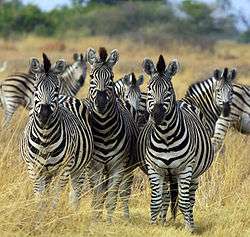
Equines are social animals with two basic social structures. Horses, plains zebras and mountain zebras live in stable, closed family groups or harems consisting of one adult male, several females and their offspring. These groups have their own home ranges which overlap and they tend to be nomadic. The stability of the group remains even when the family stallion dies or is displaced. Plains zebra groups gather into large herds and may create temporarily stable subgroups within a herd, allowing individuals to interact with those outside their group. Among harem-holding species, this behavior has only otherwise been observed in primates like the gelada and the hamadryas baboon. Females of harem species benefit as males give them more time for feeding, protection for their young, as well as protection from predators and harassment by outside males. Among females in a harem, a linear dominance hierarchy exists based on the time at which they join the group. Harems travel in a consistent filing order with the high-ranking mares and their offspring leading the groups followed by the next highest ranking mare and her offspring and so on. The family stallion takes up the rear. Social grooming (which involves individuals rubbing their heads against each other and nipping with the incisors and lips) is important for easing aggression and maintaining social bonds and status. Young of both sexes leave their natal groups as they mature; females are usually abducted by outside males to be included as permanent members of their harems.[7][26][35]
In Grévy's zebras and the wild ass species, adults have more fluid associations and adult males will establish large territories and monopolize the females that enter them. These species live in habitats with sparser resources and standing water and grazing areas may be separated. Groups of lactating females are able to remain in groups with non-lactating ones and usually gather at foraging areas. The most dominant males establish territories near watering holes, where more sexually receptive females gather. Subdominants have territories farther away, near foraging areas. Mares may wander through several territories but will remain in one when they have young. Staying in a territory offers a female protection from harassment by outside males, as well as access to a renewable resource. Some feral populations of horse exhibit features of both the harem and territorial social systems.[7][26][35]
In both equine social systems, excess males gather in bachelor groups. These are typically young males who are not yet ready to establish a harem or territory. With the plains zebra, the males in a bachelor group have strong bonds and have a linear dominance hierarchy. Fights between males usually occur over estrus females and involve biting and kicking.[7][26][35]
Communication

When meeting for the first time or after they have separated, individuals may greet each other by rubbing and sniffing their noses followed by rubbing their cheeks, moving their noses along their bodies and sniffing each other's genitals. They then may rub and press their shoulders against each other and rest their heads on one another. This greeting is usually performed among harem or territorial males or among bachelor males playing.[26]
Equines produce a number of vocalizations and noises. Loud snorting is associated with alarm. Squealing is usually made when in pain, but bachelors will also squeal while play fighting. The contact calls of equines vary from the whinnying and nickering of the horse, the barking of plains zebras, and the braying of asses and Grévy's zebras. Equines also communicate with visual displays and the flexibility of their lips allows them to make complex facial expressions. Visual displays also incorporate the positions of the head, ears and tail. An equine may signal an intention to kick by laying back its ears and sometimes lashing the tail. Flattened ears, bared teeth and abrupt movement of the heads may be used as threatening gestures, particularly among stallions.[26]
Reproduction and parenting

Among harem-holding species, the adult females mate only with their harem stallion, while in other species, mating is more promiscuous and the males have larger testes for sperm competition.[36] Estrous in female equines lasts 5–10 days; physical signs include frequent urination, flowing muscus, and a swollen, everted labia. In addition, estrous females will stand with their hind legs spread and raise their tails when in the presence of a male. Males assess the female's reproductive state with the flehmen response and the female will solicit mating by backing in. Length of gestation varies by species, it is roughly 11 to 13 months, and most mares will come into estrus again within a few days after foaling, depending on conditions.[26] Usually, only a single foal is born, which is capable of running within an hour. Within a few weeks, foals will attempt to graze, but may continue to nurse for 8–13 months.[7] Species in arid habitats, like the Grévy's zebra, have longer nursing intervals and do not drink water until they are three months old.[37]
Among harem-holding species, foals are cared for mostly by their mothers, but if threatened by predators, the entire group works together to protect all the young. The group forms a protective front with the foals in the center and the stallion will rush at predators that come too close.[26] In territory-holding species, mothers may gather into small groups and leave their young in "kindergartens" under the guard of a territorial male while searching for water.[37] Grévy's zebra stallions may look after a foal in his territory to ensure that the mother stays, even though it may not be his.[35]
Human relations

The earliest archaeological evidence for the domestication of the horse comes from sites in Ukraine and Kazakhstan, dating to approximately 4000-3500 BC.[38][39] By 3000 BC, the horse was completely domesticated and by 2000 BC there was a sharp increase in the number of horse bones found in human settlements in northwestern Europe, indicating the spread of domesticated horses throughout the continent.[40] The most recent, but most irrefutable, evidence of domestication comes from sites where horse remains were interred with chariots in graves of the Sintashta and Petrovka cultures c. 2100 BC.[41] Studies of variation in genetic material shows that very few wild stallions, possibly all from a single haplotype, contributed to the domestic horse,[42][43][44] while many mares were part of early domesticated herds.[45][46][47]
The Przewalski's horse has been conclusively shown not to be an ancestor of the domestic horse, even though the two can hybridize and produce fertile offspring. The split between Przewalskii's horse and E. ferus caballus is estimated to have occurred 120,000– 240,000 years ago, long before domestication. Of the caballine equines, E. ferus, it is E. ferus ferus, also known as the European wild horse or "tarpan" that shares ancestry with the modern domestic horse.[48] In addition, it has also been hypothesized that tarpans that lived into modern times may have been hybridized with domestic horses.[42]
Archaeological, biogeographical, and linguistic evidence suggest that the donkey was first domesticated by nomadic pastoral people in North Africa over 5,000 years ago. The animals were used to help cope with the increased aridity of the Sahara and the Horn of Africa. Genetic evidence finds that the donkey was domesticated twice based on two distinct mitochondrial DNA haplogroups. It also points to a single ancestor, the Nubian wild ass.[49] Attempts to domesticate zebras were largely unsuccessful, though Walter Rothschild trained some to draw a carriage in England.[50]
Conservation issues

Humans have had a great impact on the populations of wild equines. Threats to wild equines include habitat destruction and conflicts with local people and livestock. Since the 20th century, wild equines have been decimated over many of their former ranges and their populations scattered. In recent centuries, two subspecies, the quagga and the tarpan, became extinct. Only the plains zebra remains numerous and widespread.[7] The IUCN lists the African wild ass as critically endangered, the Grévy's zebra, mountain zebra and Przewalski's horse as endangered, the Onager as vulnerable, the kiang as lower risk and the plains zebra as least concern.[51][52][53] The Przewalski's horse was considered to be extinct in the wild from the 1960s to 1996. However, following successful captive breeding, it has been reintroduced in Mongolia.[51]
Feral horses vary in degree of protection and generate considerable controversy. For example, in Australia, they are considered a non-native invasive species, often viewed as pests, though are also considered to have some cultural and economic value.[54] In the United States, feral horses and burros are generally considered an introduced species because they are descendants from domestic horses brought to the Americas from Europe.[55] While they are viewed as pests by many livestock producers, conversely, there is also a view that E. ferus caballus is a reintroduced once-native species returned to the Americas that should be granted endangered species protection.[56] At present, certain free-roaming horses and burros have federal protection as "living symbols of the historic and pioneer spirit of the West" under the Wild and Free-Roaming Horses and Burros Act of 1971,[57] and in Kleppe v. New Mexico, the United States Supreme Court ruled that the animals so designated were, as a matter of law, wildlife.[58]
Notes
References
- ↑ equus, Charlton T. Lewis, Charles Short, A Latin Dictionary, on Perseus Digital Library
- ↑ ἵππος, Henry George Liddell, Robert Scott, A Greek-English Lexicon, on Perseus Digital Library
- ↑ ἴκκος, Henry George Liddell, Robert Scott, A Greek-English Lexicon, on Perseus Digital Library
- ↑ Introduction to Ionic Dialect Brett Mulligan, "Introduction to Ionic Dialect", Haverford College Classics Department, accessed March 10, 2012
- ↑ Palaeolexicon, Word study tool of ancient languages
- 1 2 3 4 5 Vilstrup, Julia T.; et al. (2013). "Mitochondrial Phylogenomics of Modern and Ancient Equids". PLoS ONE. 8 (2): e55950. doi:10.1371/journal.pone.0055950.
- 1 2 3 4 5 6 7 8 9 10 11 Rubenstein, D. I. (2001). "Horse, Zebras and Asses". In MacDonald, D. W. The Encyclopedia of Mammals (2nd ed.). Oxford University Press. pp. 468–473. ISBN 978-0-7607-1969-5.
- 1 2 MacFadden, B. J. (March 18, 2005). "Fossil Horses--Evidence for Evolution". Science. 307 (5716): 1728–1730. doi:10.1126/science.1105458. PMID 15774746.
- 1 2 Azzaroli, A. (1992). "Ascent and decline of monodactyl equids: a case for prehistoric overkill" (PDF). Ann. Zool. Finnici. 28: 151–163.
- ↑ Ludovic Orlando, Aurélien Ginolhac, Guojie Zhang et al. (2013). "Recalibrating Equus evolution using the genome sequence of an early Middle Pleistocene horse". Nature. 499 (7456): 74–8. doi:10.1038/nature12323. PMID 23803765.
- 1 2 Forstén, Ann (1992). "Mitochondrial‐DNA timetable and the evolution of Equus: of molecular and paleontological evidence" (PDF). Annales Zoologici Fennici. 28: 301–309.
- 1 2 Orlando, L.; et al. (2008). "Ancient DNA Clarifies the Evolutionary History of American Late Pleistocene Equids". Journal of Molecular Evolution. 66 (5): 533–538. doi:10.1007/s00239-008-9100-x. PMID 18398561.
- 1 2 Weinstock, J.; et al. (2005). "Evolution, systematics, and phylogeography of Pleistocene horses in the New World: a molecular perspective". PLoS Biology. 3 (8): e241. doi:10.1371/journal.pbio.0030241. PMC 1159165
 . PMID 15974804. Retrieved 2008-12-19.
. PMID 15974804. Retrieved 2008-12-19. - ↑ Guthrie, R. D. (2003-11-13). "Rapid body size decline in Alaskan Pleistocene horses before extinction". Nature. 426 (6963): 169–171. doi:10.1038/nature02098. PMID 14614503. Retrieved 2010-12-30.
- ↑ Buck, Caitlin E.; Bard, Edouard (2007). "A calendar chronology for Pleistocene mammoth and horse extinction in North America based on Bayesian radiocarbon calibration". Quaternary Science Reviews. 26 (17–18): 2031. doi:10.1016/j.quascirev.2007.06.013.
- ↑ Singer, Ben. "A brief history of the horse in America: Horse phylogeny and evolution". Canadian Geographic. Retrieved 13 August 2014.
- ↑ "Fossilworks: Equus fraternus". fossilworks.org. Retrieved 2016-04-23.
- ↑ "Befuddling Birth: The Case of the Mule's Foal". All Things Considered. National Public Radio. Retrieved 2008-08-16.
- ↑ "Mule Information". BMS Website. British Mule Society. Retrieved 2008-07-10.
- ↑ "Zebra hybrid is cute surprise". BBC News. June 26, 2001. Retrieved 2010-02-06.
- ↑ Megersa, B.; Biffa, D.; Kumsa, B. (2006). "A mysterious zebra-donkey hybrid (zedonk or zonkey) produced under natural mating: A case report from Borana, southern Ethiopia". Animal Production Research Advances. 2 (3): 148–154. doi:10.4314/apra.v2i3.36328.
- ↑ J. E. Cordingley, S. R. Sundaresan, I. R. Fischhoff, B. Shapiro, J. Ruskey, D. I. Rubenstein (2009). "Is the endangered Grevy's zebra threatened by hybridization?" (PDF). Animal Conservation. 12 (6): 505–13. doi:10.1111/j.1469-1795.2009.00294.x.
- ↑ Whitaker, Julie; Whitelaw, Ian (2007). The Horse: A Miscellany of Equine Knowledge. New York: St. Martin's Press. pp. 23,. ISBN 0-312-37108-X.
- ↑ Bongianni, Maurizio (1987). Simon & Schuster's Guide to Horses and Ponies. New York: Fireside. pp. 86, 96, 97. ISBN 0-671-66068-3.
- ↑ McBane, Susan (1997). The Illustrated Encyclopedia of Horse Breeds. Edison, NJ: Wellfleet Press. p. 200. ISBN 0-7858-0604-0. OCLC 244110821.
- 1 2 3 4 5 6 7 8 9 10 11 Estes, R. (1991). The Behavior Guide to African Mammals. University of California Press. pp. 235–240. ISBN 0-520-08085-8.
- ↑ Lusis, JA (1943). "Striping patterns in domestic horses". Genetica. 23 (1): 31–62. doi:10.1007/BF01763802. Retrieved 2008-06-20.
- ↑ Castle, Nancy (2008). "Primitive Marking Theory" (PDF). Dun Central Station. Archived from the original (PDF) on May 16, 2008. Retrieved 2008-06-20.
- ↑ Stachurska, AM (1999). "Inheritance of primitive markings in horses". J. Anim. Breed. Genet. 116: 29–38. doi:10.1111/j.1439-0388.1999.00172.x.
- 1 2 Caro, T.; Izzo, A.; Reiner, R. C.; Walker, H.; Stankowich, T (2014). "The function of zebra stripes". Nature Communications. 5. doi:10.1038/ncomms4535.
- ↑ Staff. "Wild Horse and Burro Myths and Facts". Bureau of Land Management. Retrieved 2014-08-15.
- ↑ Dawson, Michelle (August 2009). "Aerial survey of feral horses in the Australian Alps". Australian Alps National Parks. Retrieved 2014-08-13.
- ↑ "Animal Structure & Function". Science on the Farm. University of Waikato. Retrieved 2014-08-13.
- ↑ Pastor, J.; Cohen, Y.; Hobbs, T. (2006). "The roles of large herbivores in ecosystem nutrient cycles". In Danell, K. Large Herbivore Ecology, Ecosystem Dynamics and Conservation. Cambridge University Press. p. 295. ISBN 978-0-521-53687-5.
- 1 2 3 4 Rubenstein, D. I. (1986). "Ecology and sociality in horses and zebras". In D. I. Rubenstein; R. W. Wrangham. Ecological Aspects of Social Evolution (PDF). Princeton University Press. pp. 282–302. ISBN 0-691-08439-4.
- ↑ Ginsberg, R., D. I. Rubenstein (1990). "Sperm competition and variation in zebra mating behavior" (PDF). Behavioral Ecology and Sociobiology. 26 (6): 427–34. doi:10.1007/BF00170901.
- 1 2 Becker, C. D.; Ginsberg, J. R. (1990). "Mother-infant Behaviour of Wild Grevy's Zebra". Animal Behavior. 40 (6): 1111–1118. doi:10.1016/S0003-3472(05)80177-0.
- ↑ Outram, A.K., Stear, N.A., Bendrey, R., Olsen, S., Kasparov, A., Zaibert, V., Thorpe, N. and Evershed, R.P. 2009 The Earliest Horse Harnessing and Milking Science. 323(5919): 1332–1335
- ↑ Matossian Shaping World History p. 43 See also: "Horsey-aeology, Binary Black Holes, Tracking Red Tides, Fish Re-evolution, Walk Like a Man, Fact or Fiction". Quirks and Quarks Podcast with Bob Macdonald. CBC Radio. 2009-03-07. Retrieved 2010-09-18.
- ↑ Evans, James Warren, (1992) Horse Breeding and Management, Elsevier Science, p.56
- ↑ Kuznetsov, P. F. (2006). "The emergence of Bronze Age chariots in eastern Europe". Antiquity. 80: 638–645. doi:10.1017/s0003598x00094096.
- 1 2 Kavar, Tatjana; Dovč, Peter (2008). "Domestication of the horse: Genetic relationships between domestic and wild horses". Livestock Science. 116 (1-3): 1–14. doi:10.1016/j.livsci.2008.03.002.
- ↑ Lau, A. N., Peng, L., Goto, H., Chemnick, L., Ryder, O. A. & Makova, K. D. (2009). "Horse Domestication and Conservation Genetics of Przewalski's Horse Inferred from Sex Chromosomal and Autosomal Sequences". Molecular Biology and Evolution. 26 (1): 199–208. doi:10.1093/molbev/msn239. PMID 18931383.
- ↑ Lindgren, Gabriella; Niclas Backström; June Swinburne; Linda Hellborg; Annika Einarsson; Kaj Sandberg; Gus Cothran; Carles Vilà; Matthew Binns; Hans Ellegren (2004). "Limited number of patrilines in horse domestication". Nature Genetics. 36 (4): 335–336. doi:10.1038/ng1326. PMID 15034578.
- ↑ Lira, Jaime; et al. (2010). "Ancient DNA reveals traces of Iberian Neolithic and Bronze Age lineages in modern Iberian horses". Molecular Ecology. 19 (1): 64–78. doi:10.1111/j.1365-294X.2009.04430.x. PMID 19943892.
- ↑ Vilà, C.; et al. (2001). "Widespread origins of domestic horse lineages". Science. 291 (5503): 474–477. doi:10.1126/science.291.5503.474. PMID 11161199.
- ↑ Cai, D. W.; Tang, Z. W.; Han, L.; Speller, C. F.; Yang, D. Y. Y.; Ma, X. L.; Cao, J. E.; Zhu, H.; Zhou, H.; et al. (2009). "Ancient DNA provides new insights into the origin of the Chinese domestic horse" (PDF). Journal of Archaeological Science. 36 (3): 835–842. doi:10.1016/j.jas.2008.11.006. Retrieved 17 January 2011.
- ↑ Kefena, E. et. al (2012). "Discordances between morphological systematics and molecular taxonomy in the stem line of equids: A review of the case of taxonomy of genus Equus". Livestock Science. 143 (2-3): 105–115. doi:10.1016/j.livsci.2011.09.017.
- ↑ Kimura, B. et. al. (2010). "Ancient DNA from Nubian and Somali wild ass provides insights into donkey ancestry and domestication". Proceedings of the Royal Society B. 278 (1702): 50–57. doi:10.1098/rspb.2010.0708.
- ↑ Young, R. "Can Zebras Be Domesticated and Trained?". Slate. Retrieved 2014-08-04.
- 1 2 Boyd, L. & King, S. R. B. (2011). "Equus ferus ssp. przewalskii". IUCN Red List of Threatened Species. Version 2011.2. International Union for Conservation of Nature. Retrieved June 24, 2012.
- ↑ Hack, M. A. and Lorenzen, E. (2008). "Equus quagga". IUCN Red List of Threatened Species. Version 2008. International Union for Conservation of Nature. Retrieved 10 April 2009. Check date values in:
|access-date=(help) - ↑ Moelman, P.D. Equids: Zebras, Assess and Horses. Status Survey and Conservation Action Plan. IUCN/SSC Equid Specialist Group. p. ix. ISBN 2-8317-0647-5.
- ↑ "Australia Government Department of the Environment and Heritage. (2004) Feral horse. (Equus caballus) and feral donkey. (Equus asinus): Invasive species fact sheet". Retrieved 2014-08-18.
- ↑ "Feral Horses: Get The Facts" (PDF). The Wildlife Society. Retrieved 4 April 2012.
- ↑ Klein, Karin (July 3, 2014). "Is America's wild horse an invasive species, or a reintroduced native?". Los Angeles Times. Retrieved August 18, 2014.
- ↑ "Pryor Mountains Wild Horse Range". Billings Field Office . Bureau of Land Management. U.S. Department of the Interior. May 2, 2011. Retrieved 2011-05-27.
- ↑ Flores, Dan Louie. (1999). Horizontal Yellow: Nature and History in the Near Southwest. Albuquerque, N.M.: University of New Mexico Press. p. 121.
External links
| Look up Equus, equus, or equine in Wiktionary, the free dictionary. |
.jpg)